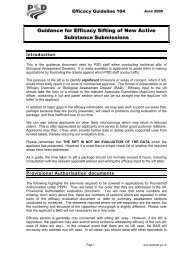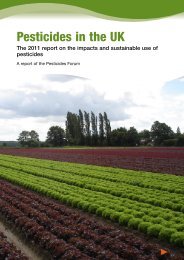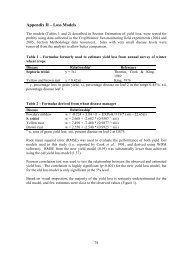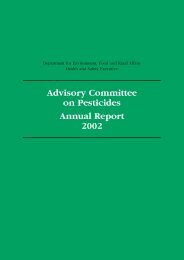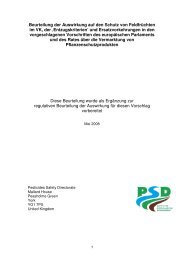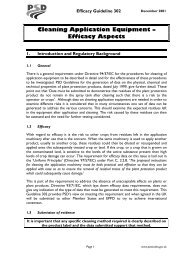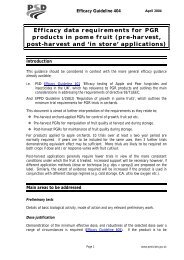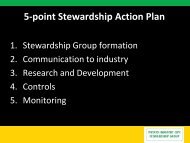Advisory Committee on Pesticides Annual Report 2001
ACP Annual Report 2001 - Pesticides Safety Directorate
ACP Annual Report 2001 - Pesticides Safety Directorate
Create successful ePaper yourself
Turn your PDF publications into a flip-book with our unique Google optimized e-Paper software.
Secti<strong>on</strong> E: UK Review Programme<br />
and n<strong>on</strong>-agricultural uses of dichlorvos. This advice was given as a<br />
precauti<strong>on</strong>ary measure, since the possibility of genotoxic carcinogenicity could<br />
not be excluded. The ACP c<strong>on</strong>sidered that any risk of human carcinogenicity<br />
was likely to be very small, and would be mainly associated with certain uses<br />
in the home and with exposures to some operators in the agricultural sector.<br />
Before such regulatory acti<strong>on</strong> could be carried out, AMVAC Chemical UK Ltd<br />
(an approval holder and manufacturer of dichlorvos) obtained an injuncti<strong>on</strong>,<br />
which prevented regulatory acti<strong>on</strong>. Government agencies were also prohibited<br />
from making any announcement to the public about the regulatory acti<strong>on</strong> that<br />
was proposed. AMVAC also gained permissi<strong>on</strong> for a judicial review hearing,<br />
which was heard in November <strong>2001</strong>.<br />
The grounds for the challenge were that AMVAC had not been properly<br />
informed of the proposed regulatory acti<strong>on</strong> or the basis for it, and had not<br />
been given sufficient time to make representati<strong>on</strong>s. AMVAC also claimed that<br />
Ministers had not given proper regard to the precauti<strong>on</strong>ary principle and to<br />
the European C<strong>on</strong>venti<strong>on</strong> <strong>on</strong> Human Rights.<br />
The judgement of the Court was issued in December <strong>2001</strong>. Mr Justice Crane<br />
rejected most of the company’s submissi<strong>on</strong>s, including those c<strong>on</strong>cerning the<br />
precauti<strong>on</strong>ary principle and the C<strong>on</strong>venti<strong>on</strong> <strong>on</strong> Human Rights. However, he<br />
ruled that the company had been given insufficient time to resp<strong>on</strong>d to the<br />
c<strong>on</strong>clusi<strong>on</strong>s of the Government’s expert advisers prior to regulatory acti<strong>on</strong><br />
being taken. He accepted that the matter was urgent but c<strong>on</strong>sidered that the<br />
claimant had now had full opportunity to present any further material.<br />
59<br />
During the period of the injuncti<strong>on</strong>, the ACP was unable to publish the<br />
minutes of its meetings. The ACP had c<strong>on</strong>cerns that this compromised the<br />
openness of the advice given to Ministers, and could thereby have an adverse<br />
effect <strong>on</strong> public c<strong>on</strong>fidence in the regulatory process. It was also c<strong>on</strong>cerned<br />
that speculati<strong>on</strong> about the missing minutes might create unwarranted public<br />
anxiety. Notwithstanding these c<strong>on</strong>cerns, the ACP agreed that while rapid<br />
implementati<strong>on</strong> of regulatory acti<strong>on</strong> was desirable <strong>on</strong>ce decisi<strong>on</strong>s had been<br />
made, it was also important that the regulatory process be fair and open to<br />
scrutiny. In this case, the ACP’s advice to Ministers had been precauti<strong>on</strong>ary<br />
(i.e. based <strong>on</strong> insufficient reassurance that exposures to the compound were<br />
acceptable rather than direct evidence that people were being harmed), and<br />
the delay caused by the legal acti<strong>on</strong> would be acceptable provided that it was<br />
not unduly prol<strong>on</strong>ged.




